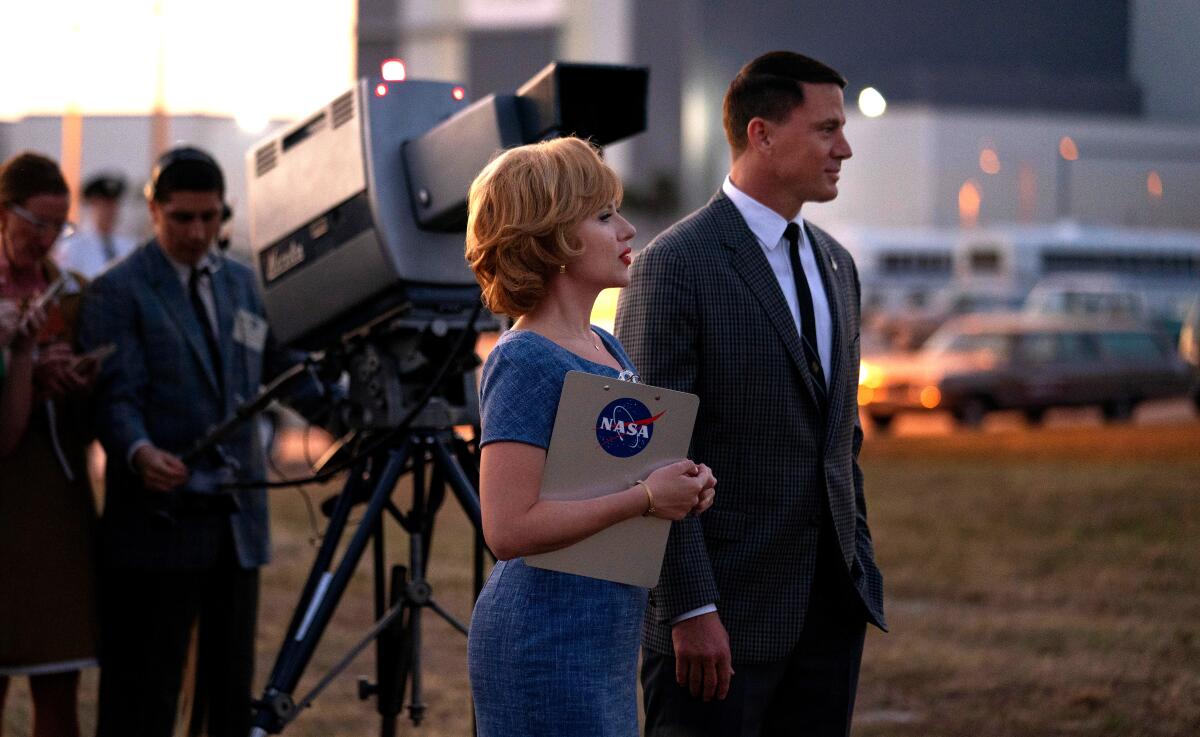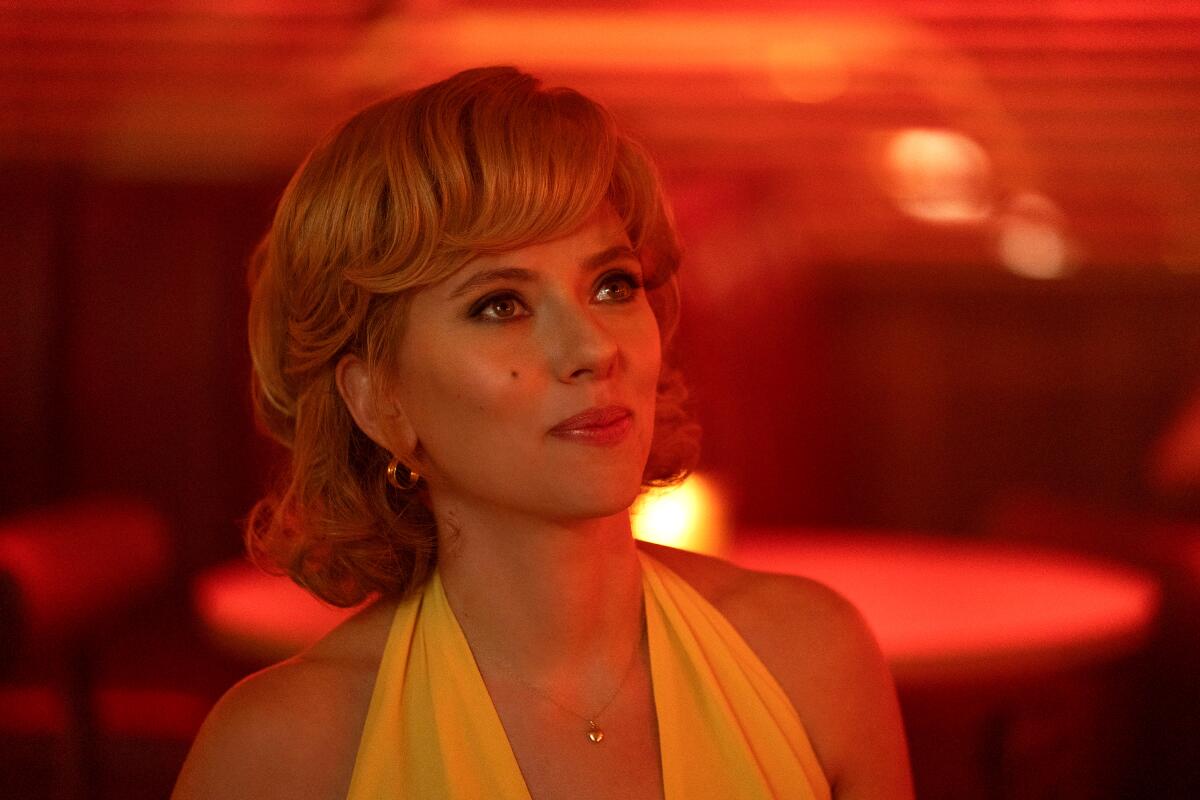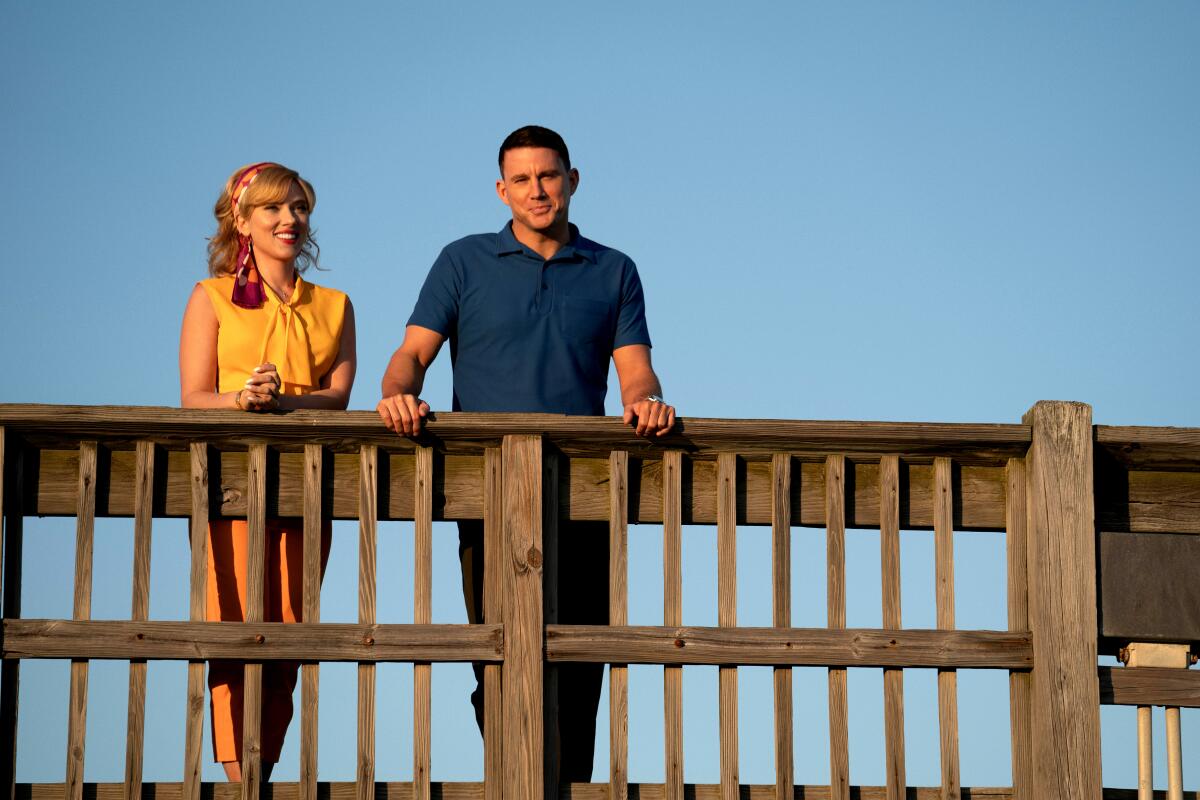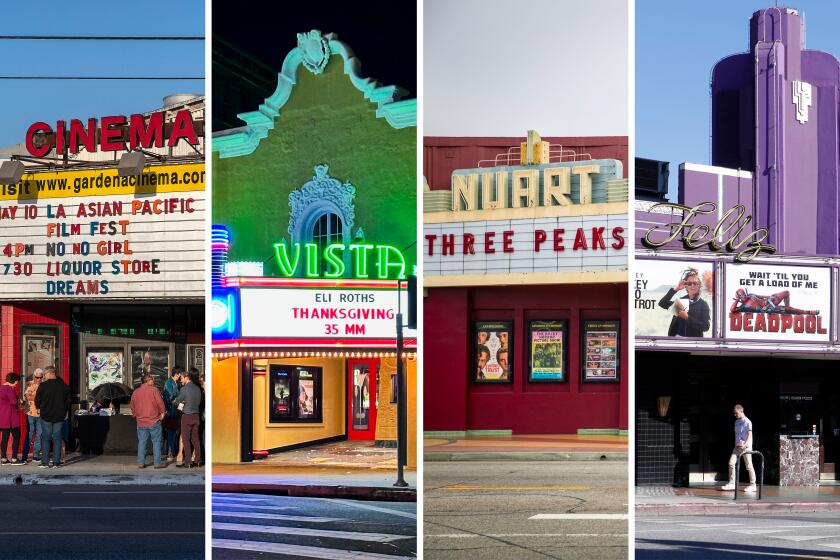Review: In fizzy facts-optional ‘Fly Me to the Moon,’ faking Apollo 11 and falling in love

- Share via
It may not have all the right stuff, but what “Fly Me to the Moon” lacks in narrative coherence and tonal consistency it makes up for, in part, by simply existing. If that sounds like damning with faint praise, it is. By all rights, the movie, set mainly in 1969 during the lead-up to NASA’s Apollo 11 lunar landing, should have been a far sharper, kickier, more propulsive ride.
That said, general audiences may find the film a sufficiently entertaining throwback — the kind of glossy, star-driven, big-canvas, IP-free picture that’s been in short supply on theater screens for way too long. And the potential of sparks flying between stars Scarlett Johansson and Channing Tatum certainly has its heart-swelling appeal.
The result, though, directed by Greg Berlanti (“Love, Simon”) from a script by first-time feature writer Rose Gilroy (from a story by Keenan Flynn and Bill Kirstein), is a nostalgic, wannabe-screwball rom-com that’s sadly light on both the “rom” and the “com.” As the movie goes on, the plot becomes as distracted as my Labrador retriever on squirrel watch.
Johansson, also a producer here, shines as Kelly Jones, a New York marketing dynamo with a penchant for stretching the truth if it means sealing a deal. Little does she know she’s being tracked by Moe Berkus (Woody Harrelson), a shadowy operative working for then-President Richard Nixon, who hires Kelly to help sell the looming moon mission to an uneasy and cynical American public. This is, after all, the fraught era of the Vietnam War, which has already divided a nation — and an electorate.

Kelly jets down to Florida to set up shop with her trusty Nixon-despising assistant, Ruby (a winning Anna Garcia), at the Kennedy Space Center. (The film was shot there with the full cooperation of NASA). In no time, Kelly is spinning heads — and narratives — as she starts whipping together a rah-rah, whatever-it-takes promotional campaign to indelibly elevate the image of the Apollo 11 operation and its astronauts in the minds of Americans and the world.
Then there’s Cole Davis (Tatum), NASA’s stalwart, no-frills launch director. He’s an ex-Air Force pilot — and rejected astronaut — haunted by the fiery, fatal failure of the Apollo 1 mission less than two years earlier. After flaming out during a strained meet-cute with Kelly at a local diner, he’s irked to discover that she’s now a fixture at Cape Kennedy, calling some of the shots that were formerly his to make.
The inevitable head-butting, sexually tense banter between the super-serious (and frankly dull) Cole and the vivacious, near-magically-capable Kelly never quite takes off, nor, surprisingly, does the chemistry between the two leads. Cole is so tense and unduly hostile toward Kelly at first that, when they start to see more eye-to-eye (and, yes, mouth-to-mouth), you wonder what exactly draws Kelly to him, save that he looks fetching in colorful knit turtlenecks.
The script attempts to layer in enough backstory to explain, if not justify, Cole’s fustiness, but it doesn’t make him any more engaging. Whether it’s the writing or the direction, even when his character lightens up, Tatum still comes off a bit stiff.

Kelly and Cole’s budding romance (and the film’s limited comedy) soon takes a back seat to the story’s second-act curveball. That’s when Moe orders a reluctant Kelly to stage and film a mock moon landing in a studio that can be broadcast to the world to save America’s face — particularly against chief space-race competitor the Soviet Union — should the mission tank. (The visual part would be a simulation but the audio feed would remain real.) Oh, and everyone involved in creating this “alternate version,” also known as Project Artemis, must be sworn to eternal secrecy. That means no one outside of this covertly shot production, including Cole and the entire NASA team, can know the truth.
There are too many holes in this big-swing plot development to parse; it’s best just to go with it. It’s a disruptive yet intriguing (and, let’s be clear, entirely fictional) segue that plays off the longtime conspiracy theory that the moon landing was faked.
Unfortunately, this strand nudges things into light action-thriller territory, complicating the story, forcing a predictable rift between the truth-flexible Kelly and Boy Scout-honest Cole, and overextending the film’s running time.
From a technical standpoint, the movie proves a solid watch as it mixes memorable bits of archival footage from the actual Apollo 11 mission and its attendant media coverage with vibrant cinematography by Dariusz Wolski, who also plays the bogus moon landing’s expert cameraman. Kudos as well to film editor Harry Jierjian, production designer Shane Valentino, costumer Mary Zophres and the picture’s sound design and editing team for their first-rate contributions.
We’ve mapped out 27 of the best movie theaters in L.A., from the TCL Chinese and the New Beverly to the Alamo Drafthouse and which AMC reigns in Burbank.
As for the rest of the movie’s large cast, Harrelson is a hoot, stealing his share of scenes as the stealthy Moe attempting to manipulate history via Kelly, who’s got a few skeletons in her closet. Ray Romano is his welcome hangdog self as a veteran NASA engineer, Donald Elise Watkins and Noah Robbins charm as a pair of eager young technicians, and Colin Jost (Johansson’s husband) and Victor Garber pop up in enjoyable cameos as pivotal U.S. senators. A nimble black cat also factors in.
It should be said, however, that Jim Rash sets the image of gay men back, at least to 1969, in his turn as Tab-swilling, ascot-wearing, limp-wristed fusspot Lance Vespertine, the commercial director brought in to helm the ersatz moon-landing shoot. His hoary portrayal is a head-scratching misstep. Comic relief? Sorry, no.
Also strange is the omission of Frank Sinatra’s iconic 1960s hit, “Fly Me to the Moon,” which features such other decade-appropriate needle-drops as Aretha Franklin’s take on “Moon River” and the Bee Gees’ “To Love Somebody.” Yes, “Fly Me” is heard in a few other incarnations, but given that Ol’ Blue Eyes’ version was played when Buzz Aldrin stepped onto the moon’s surface, its inclusion here would seem like a guaranteed smile in a film that contains most of the elements of a crowd-pleaser — but not quite the right formula. Maybe they are rocket science after all.
'Fly Me to the Moon'
Rated: PG-13, for some strong language and smoking
Running time: 2 hours, 12 minutes
Playing: In wide release Friday, July 12
More to Read
Only good movies
Get the Indie Focus newsletter, Mark Olsen's weekly guide to the world of cinema.
You may occasionally receive promotional content from the Los Angeles Times.











